T
|
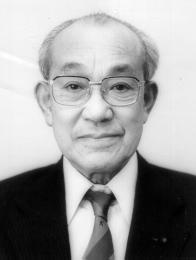
HANSHI 9th dan - J.K.F. SHITO-KAI
World Shito-ryu Karate-do Federation Senior Advisor
Born in Chuo-ku, Kobe-shi, Hyogo, Japan on February 10, 1916, TSUJIKAWA YOSHIAKA HANSHI graduated from Daisan Shinko Municipal Commercial School and Kansai Acupuncture and Moxa cautery and Jusei College. Tsujikawa Hanshi actually first began studying Karate-do in January 1934 from a book written by the famous "Father of Modern Karate-do, Gichin Funakoshi".
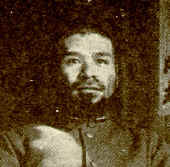
Early school picture of Tsujikawa sensei
In July, 1935 Tsujikawa sensei joined the "Dai Nippon Karate-do Kai" Hyogo Branch which was under the direction of Nishikawa Eiji at the time. During 1936 Tsujikawa Yoshiaki sensei joined the head office of the Dai Nippon Karate-do Kai and began receiving instruction directly from Master Mabuni Kenwa, founder of Shito-ryu Karate-do.
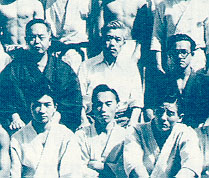
(L-R): Master
Mabuni, unknown, Yoshiaki Tsujikawa.
Tsujikawa sensei recalls fondly the days of training at the Dai Nippon Karate-do Kai under Master Mabuni Kenwa. He remembers during 1937 Master Mabuni with his gentle look, sitting in front flanked by Takemasa Tomoyori and Yoshikatsu Hase. The practice at the time he recalls comprised mostly of kata and kumite (with fixed offence and defense sides). Free sparring or jiu-kumite was only used on special occasions. The training was rough and hard. Punches (tsuki) and kicks (keri) were actually made without stopping, and throws (nage) and take-downs (gyaku) were also used. The Karate-gi (uniform) was not like what is used today Tsujikawa sensei recalls. They would use Kendo's quilted jackets and Judo's trousers. Quite often during the hard training, the uniforms used to be torn off. Tsujikawa sensei remembers the lessons of Master Mabuni were very severe, unlike the gentler style later on.
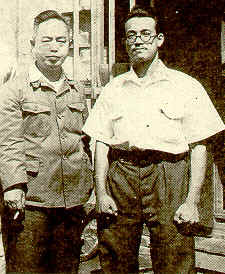
Master Mabuni with his student Yoshiaki Tsujikawa (1946).
Throughout the turmoil of the post-war era, Master Mabuni, though contending with poverty, endeavoured to contribute to the reconstruction of Japan by the spreading of karate-do, and devoting his life to the promotion of Shito-ryu Karate-do.
During 1938, Yoshiaki Tsujikawa sensei became the leader of the Dai Nippon Karate-do Kai, Hyogo Branch. By 1941, Tsujikawa sensei established his Kobukan dojo for the purpose of cultivating leaders for Karate-do. In April 1950, he changed the name of his dojo from Kobukan to Yoshinkan.
In August 1974, Tsujikawa sensei received a "Person of Merit for Sports" award from the Hyogo Sports Association; January 1985, received a "Person of Merit for Budo" award from the Japanese Budo Association; October 1988, received a "Person of Merit for Sports in Kobe" award from the Mayor Of Kobe.
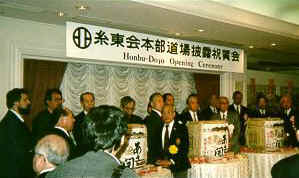
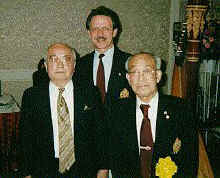
Honbu Dojo Opening Ceremonies: Mabuni Kenei Soke and Tsujikawa Hanshi
with Sam Moledzki
(Shito-kai Canada Shibucho) in the background.
During April 1997, Tsujikawa sensei was an honoured guest at the official Honbu Dojo Opening Ceremonies and presently serves as an Advisor for the All Japan Karate-do Federation.
References/Bibliography
W.S.K.F.-World Shito-ryu Karate-do Federation Inaugural Programme /Magazine Issue: Tokyo, Japan. 1993.
Yukyu No Ken - All Japan Karate-do Shito-kai Federation Issue: Tokyo, Japan.
Moledzki Sam. Personal Data & Photograph Archives: Toronto, Canada